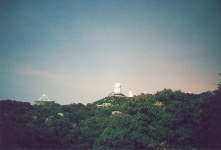
| 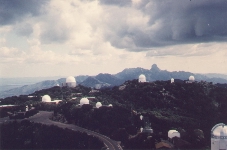
| 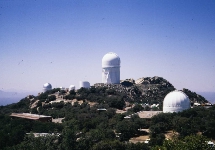
|
My introduction to big telescopes came on Kitt Peak, when Dan Weedman brought me along for galaxy photometry in June 1977 (the same week that Star Wars opened for the first time). After doing some narrowband imaging at the 2.1m as part of my thesis work, I spent three years as a Kitt Peak (later NOAO) postdoc.

| 
| 
|
There is a satellite image from Google Maps of the summit. The 4-meter dome is prominent at the north end, with the 2.1m, WIYN dome, and McMath solar telescope obvious to the south.
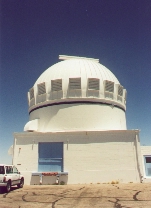
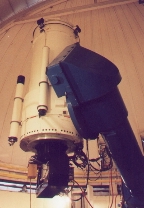 The original (#1) 0.9m at Kitt Peak was demolished to make room for the 3.5m
WIYN telescope,
with the best components of both 0.9-m telescopes going into a single new
"Frankenscope" (whose days are now numbered according to the latest
NOAO budgetary plan). The wide field of the 0.9m and an unusually extensive suite
of instruments and detectors allowed some unique studies (this picture shows
the telescope with the NOAO large-format CCD mosaic imager in place, a
pretty remarkable thing for a telescope of this size). I once spent 6
nights trying to
measure the spectra of reflection nebulae here, with the idea of seeing whether
the diffuse interstellar bands could be shown to either occur or not occur
within the nebulae. Being July in Tucson, I got about 3 hours' worth of data
and took this as a sign that I should stay outside the galaxy. Even so, the
data on NGC 7023 do show reflected stellar absorption features from the dust.
This picture shows the dome of the composite 0.9m, in its latest incarnation
after the extensive air vents were added to improve the airflow and seeing.
(The other parts not retained for this telescope went to make
up the SARA 0.9m telescope).
The original (#1) 0.9m at Kitt Peak was demolished to make room for the 3.5m
WIYN telescope,
with the best components of both 0.9-m telescopes going into a single new
"Frankenscope" (whose days are now numbered according to the latest
NOAO budgetary plan). The wide field of the 0.9m and an unusually extensive suite
of instruments and detectors allowed some unique studies (this picture shows
the telescope with the NOAO large-format CCD mosaic imager in place, a
pretty remarkable thing for a telescope of this size). I once spent 6
nights trying to
measure the spectra of reflection nebulae here, with the idea of seeing whether
the diffuse interstellar bands could be shown to either occur or not occur
within the nebulae. Being July in Tucson, I got about 3 hours' worth of data
and took this as a sign that I should stay outside the galaxy. Even so, the
data on NGC 7023 do show reflected stellar absorption features from the dust.
This picture shows the dome of the composite 0.9m, in its latest incarnation
after the extensive air vents were added to improve the airflow and seeing.
(The other parts not retained for this telescope went to make
up the SARA 0.9m telescope).
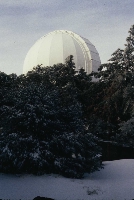
| 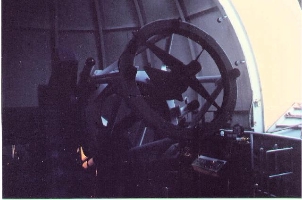
|
My first KPNO experience involved UBV photometry of galaxy nuclei as a
supplement to the survey Dan Weeman and I had been doing with photography from
Dyer Observatory. At that point, a teletype right on the observing platform
printing out the photon counts for each integration was the coolest piece of
apparatus I'd ever seen. We generated this UBV two color diagram
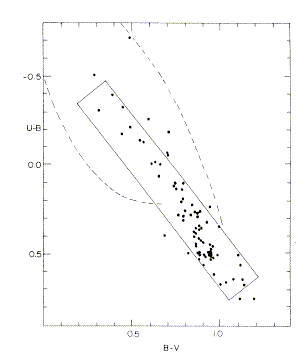 for
galactic nuclei, where the upper curve shows where Seyfert nuclei
would fall and the lower one compares the loci of individual star clusters.
Later, Peter Allan and I used the 1.3m for precise
photometric monitoring of quasar variability (just lately turned into the
Master's thesis of Jose Maria Castro Ceron).
For this project, we made optical use of
an infrared-optimized feature of the telescope - a rapidly chopping secondary mirror
which let us accumulate sky and object measures several times a second. These
results are nicely summarized in the structure function, showing the amount of
variation as a function of time (in the quasars' time frames, that is,
correcting for the apparent time dilation due to their redshift). Shortly
before the telescope was decommissioned (both for financial reasons and
because competitive infrared instrumentation was physically outgrowing its size)
I did a near-infrared survey of interacting galaxies with Gene Byrd and Mario
Klaric. Most notably, we did not find the incidence of hidden bars which some
calculations had implicated in triggering star formation and AGN during tidal
encounters between galaxies. Here are some sample 2.2-micron images of
interacting galaxies.
for
galactic nuclei, where the upper curve shows where Seyfert nuclei
would fall and the lower one compares the loci of individual star clusters.
Later, Peter Allan and I used the 1.3m for precise
photometric monitoring of quasar variability (just lately turned into the
Master's thesis of Jose Maria Castro Ceron).
For this project, we made optical use of
an infrared-optimized feature of the telescope - a rapidly chopping secondary mirror
which let us accumulate sky and object measures several times a second. These
results are nicely summarized in the structure function, showing the amount of
variation as a function of time (in the quasars' time frames, that is,
correcting for the apparent time dilation due to their redshift). Shortly
before the telescope was decommissioned (both for financial reasons and
because competitive infrared instrumentation was physically outgrowing its size)
I did a near-infrared survey of interacting galaxies with Gene Byrd and Mario
Klaric. Most notably, we did not find the incidence of hidden bars which some
calculations had implicated in triggering star formation and AGN during tidal
encounters between galaxies. Here are some sample 2.2-micron images of
interacting galaxies.
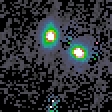 |
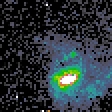 |
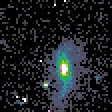 |
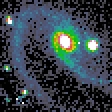 |
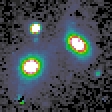 |
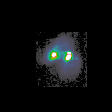 |
| Arp 191 | K016A | K016B | K064A | K107 | NGC 3690/IC 694 |
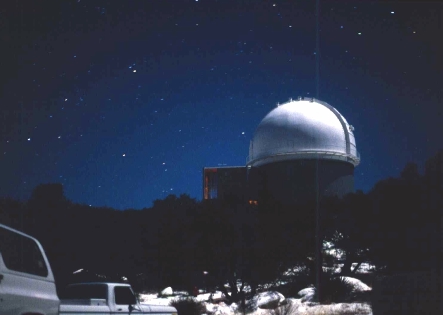
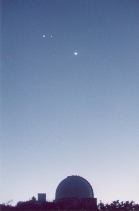
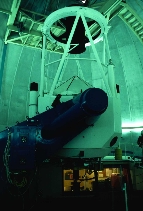 As so many other astronomers have found, this telescope has been a real
workhorse for large-scale programs, for imaging and spectroscopy alike. The
dome is shown here in front of Mars, Jupiter and Saturn during the spectacular
alignment of June 1995 (yes, for my fellow pedants out there, that's four planets
in one shot).
Both for
my dissertation work and for a later study of galaxy interactions, I used it
for H-alpha imaging of galaxies to trace how star formation and nuclear
activity vary with galaxy type and tidal disturbance. Here I show a normal
object - the beautifully outlined spiral pattern in NGC 5427 as seen in
H-alpha - and an abnormal one - the strange loops and whorls of ionized gas in
the radio source NGC 2655. In these displays, the color palette shows
varying intensities of emission from gaseous hydrogen (H-alpha) and nitrogen
(the adjacent [N II] lines). Such images can be used to measure the
space distribution and distribution in intensity of star-forming regions,
to seek clues to how galaxy interactions trigger enhanced star formation.
As so many other astronomers have found, this telescope has been a real
workhorse for large-scale programs, for imaging and spectroscopy alike. The
dome is shown here in front of Mars, Jupiter and Saturn during the spectacular
alignment of June 1995 (yes, for my fellow pedants out there, that's four planets
in one shot).
Both for
my dissertation work and for a later study of galaxy interactions, I used it
for H-alpha imaging of galaxies to trace how star formation and nuclear
activity vary with galaxy type and tidal disturbance. Here I show a normal
object - the beautifully outlined spiral pattern in NGC 5427 as seen in
H-alpha - and an abnormal one - the strange loops and whorls of ionized gas in
the radio source NGC 2655. In these displays, the color palette shows
varying intensities of emission from gaseous hydrogen (H-alpha) and nitrogen
(the adjacent [N II] lines). Such images can be used to measure the
space distribution and distribution in intensity of star-forming regions,
to seek clues to how galaxy interactions trigger enhanced star formation.
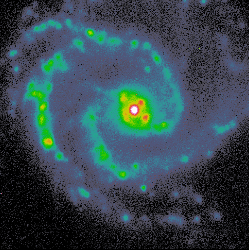
| 
|
Later on, I used its GoldCam optical spectrograph to measure rotation curves of samples of interacting spirals, both normal and Seyfert galaxies, seeking connections between AGN or star formation and these disturbances. As a sample, here is the rotation curve of the disturbed galaxy NGC 6621 (which looks correspondingly weird in both groundbased data and in the HST images that Kirk Borne and I just got). The changing sizes of the (2-sigma) error bars mostly reflect the changing intensity of H-alpha and [N II] emission lines (shown at the bottom of the plot, which traces both the continuum and emission-line intensity on an arbitrary scale along the slit).
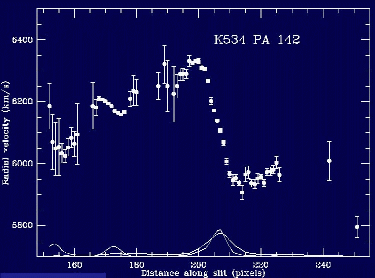
Most recently, we used the 2.1m for optical and near-IR imaging of overlapping galaxies, to trace the effects of dust absorption within galaxy disks, plus spectroscopy of these pairs which allows us to separate the contributions from each galaxy by their difference in redshift. I'll illustrate these with a sample image of AM1316-241 (no big deal compared to the WFPC2 image we got later, but we couldn't have gotten those data without the ground-based survey), and the cross-correlation of the overlapping spectra of the components of NGC 3088 (UGC 5384), showing the signatures of light from both redshifts at the same location.
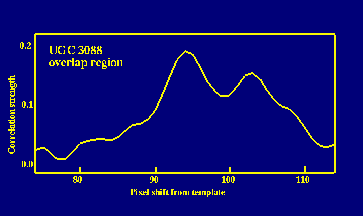
The 2.1m is also equipped with a separate feed telescope, using a fixed primary and a moving flat feed mirror to feed light from a 1m primary into the coude' spectrograph without having to use the 2.1m itself. This was so successful that, after the CFT was commissioned, the 2.1m was seldom used with the large fixed spectrograph. This view, taken a few weeks before the CFT was closed for budgetary reasons, shows the primary and light-baffle tube, looking south toward Baboquivari and Canopus. The flat mirror which controls the telescope's pointing is visible at the left; it was pointed high in the south during this picture.
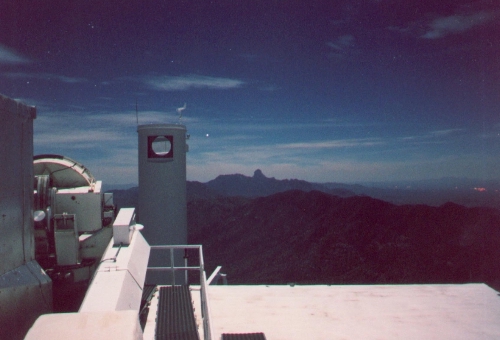
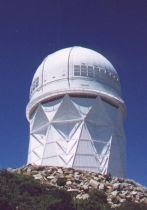
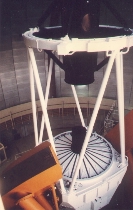 The Kitt Peak 4-meter telescope was long the crown jewel of the US national
observatories. In scattered observing
runs over the years, I've examined reported optical jets (they're mostly not),
looked at the spectra of complex galactic nuclei at high dispersion, and joined
the rush toward the epoch of galaxy formation. One particularly interesting
(and tedious) kind of observation uses the DensePak fiber-optic array to map a
14x14-arcsecond region spectroscopically, as seen in this Doppler map of the
gaseous filaments in M87 (where color corresponds to radial velocity,
and red of corse to receding areas). I also show an H-alpha image of the
filaments in NGC 1275, taken with the Cryogenic Camera in its rarely-used
imaging mode.
The Kitt Peak 4-meter telescope was long the crown jewel of the US national
observatories. In scattered observing
runs over the years, I've examined reported optical jets (they're mostly not),
looked at the spectra of complex galactic nuclei at high dispersion, and joined
the rush toward the epoch of galaxy formation. One particularly interesting
(and tedious) kind of observation uses the DensePak fiber-optic array to map a
14x14-arcsecond region spectroscopically, as seen in this Doppler map of the
gaseous filaments in M87 (where color corresponds to radial velocity,
and red of corse to receding areas). I also show an H-alpha image of the
filaments in NGC 1275, taken with the Cryogenic Camera in its rarely-used
imaging mode.
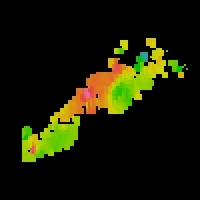 |
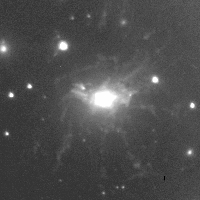 |
Lately, with Rogier Windhorst and crew, we've been using narrowband filters to map clustering at redshifts near z=2.4, dovetailing with fields observed using HST to combine its unique depth and detail with the wide field coverage afforded by the prime-focus cameras at the 4-meter telescope (which truth in advertising compels me to point out has a clear aperture closer to 3.8 meters). This field, a color composite starting from B and I broadband images, shows known and new objects at redshift z close to 2.4 found in this way. The detected objects are circled, and all appear in this subsection of the whole observed area. By now, six are spectroscopically confirmed as AGN at this redshift. The redshift and space distribution of the members indicates that we're seeing a group or cluster in formation, falling together for the first time as their mutual gravity overcomes the Hubble expansion.
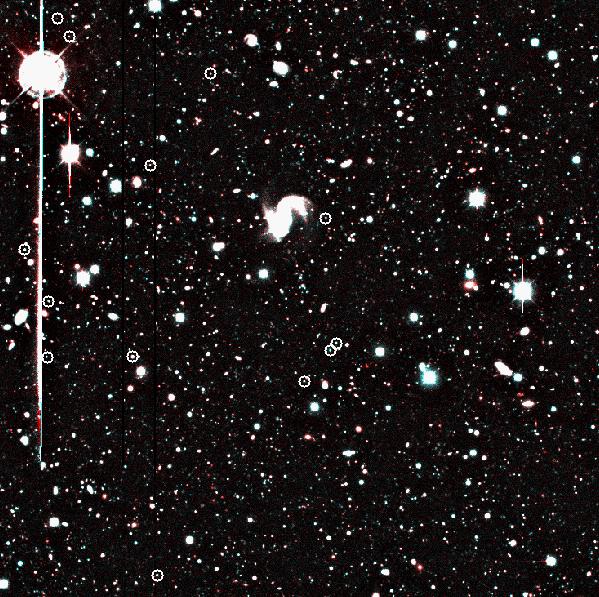
The Mosaic CCD camera enables surveys very effectively, with the 4-meter field spanning 0.5°. This is a piece of a color composite from BVR mosaic images of Abell 2125. This is a dynamically complex cluster at z=0.25, in which we found a galaxy in the process of being stripped as it orbits through the hot intergalactic gas. The victim, known as C153, is the blueish-white galaxy centered in this image (just to the lower right of the triple cD galaxy).
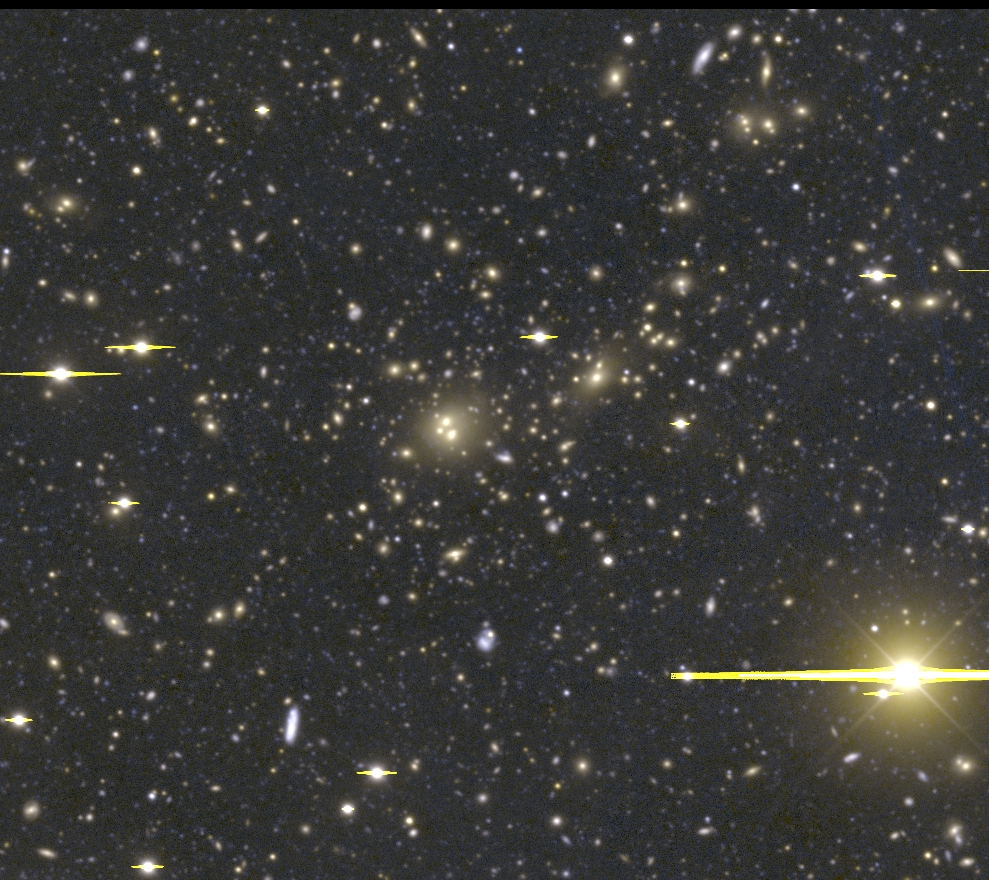
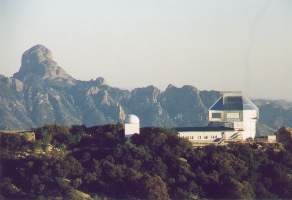
|
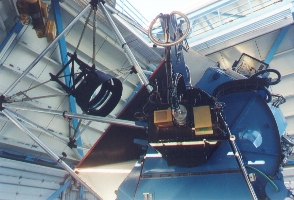 |
This shiny new addition to the Kitt Peak landscape is a great demonstration of the advances in telescope technology over the two decades since the Mayall telescope went into service. It's compact, usually delivers sharper images, and is reputed to take substantially less maintenance. WIYN stands for the project partners - Wisconsin, Indiana, Yale, and NOAO - but kept an earlier pronunciation ("win"), no matter how appropriate the current letters might seem. Alas, I never got a picture of the footprints left on the primary mirror by a ringtailed cat, so that story must remain anecdotal. The outside view contrasts the angular, metallic enclosure, including pipes to carry warm air away from the telescope, with the weathered rock of Baboquivari Peak in the distant background. The telescope picture shows the secondary mirror and lightweight support trusses, with an altitude bearing and one of the spectrograph ports at right. A particular specialty for WIYN has been multiobject spectroscopy, using the Hydra fiber-optic bundle and positioners. For this, one typically lets the data gathering be supervised by the telescope operator and queue astronomer, so you need not make the trip for a couple of hours' worth of data. We've used this for spectroscopic surveys of distant clusters of galaxies in support of VLA and HST projects, especially the merging cluster Abell 2125 which we've also observed with the Mayall telescope (in regions so crowded with galaxies that the Hydra fibers would collide with each other). More recently, I've used the DensePak fiber-optic array to map the kinematics of several interacting-galaxy systems (see the examples shown for NGC 1409/10).
Last changes: 4/2007 © 1999-2007